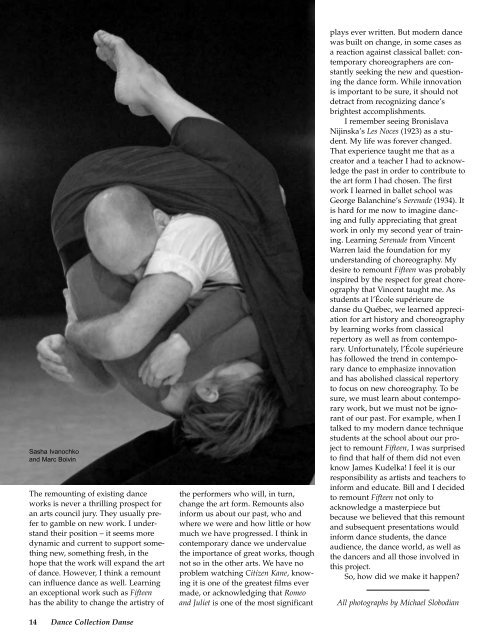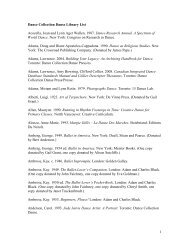Jeanne Renaud - Dance Collection Danse
Jeanne Renaud - Dance Collection Danse
Jeanne Renaud - Dance Collection Danse
Create successful ePaper yourself
Turn your PDF publications into a flip-book with our unique Google optimized e-Paper software.
Sasha Ivanochko<br />
and Marc Boivin<br />
The remounting of existing dance<br />
works is never a thrilling prospect for<br />
an arts council jury. They usually prefer<br />
to gamble on new work. I understand<br />
their position – it seems more<br />
dynamic and current to support something<br />
new, something fresh, in the<br />
hope that the work will expand the art<br />
of dance. However, I think a remount<br />
can influence dance as well. Learning<br />
an exceptional work such as Fifteen<br />
has the ability to change the artistry of<br />
14 <strong>Dance</strong> <strong>Collection</strong> <strong>Danse</strong><br />
the performers who will, in turn,<br />
change the art form. Remounts also<br />
inform us about our past, who and<br />
where we were and how little or how<br />
much we have progressed. I think in<br />
contemporary dance we undervalue<br />
the importance of great works, though<br />
not so in the other arts. We have no<br />
problem watching Citizen Kane, knowing<br />
it is one of the greatest films ever<br />
made, or acknowledging that Romeo<br />
and Juliet is one of the most significant<br />
plays ever written. But modern dance<br />
was built on change, in some cases as<br />
a reaction against classical ballet: contemporary<br />
choreographers are constantly<br />
seeking the new and questioning<br />
the dance form. While innovation<br />
is important to be sure, it should not<br />
detract from recognizing dance’s<br />
brightest accomplishments.<br />
I remember seeing Bronislava<br />
Nijinska’s Les Noces (1923) as a student.<br />
My life was forever changed.<br />
That experience taught me that as a<br />
creator and a teacher I had to acknowledge<br />
the past in order to contribute to<br />
the art form I had chosen. The first<br />
work I learned in ballet school was<br />
George Balanchine’s Serenade (1934). It<br />
is hard for me now to imagine dancing<br />
and fully appreciating that great<br />
work in only my second year of training.<br />
Learning Serenade from Vincent<br />
Warren laid the foundation for my<br />
understanding of choreography. My<br />
desire to remount Fifteen was probably<br />
inspired by the respect for great choreography<br />
that Vincent taught me. As<br />
students at l’École supérieure de<br />
danse du Québec, we learned appreciation<br />
for art history and choreography<br />
by learning works from classical<br />
repertory as well as from contemporary.<br />
Unfortunately, l’École supérieure<br />
has followed the trend in contemporary<br />
dance to emphasize innovation<br />
and has abolished classical repertory<br />
to focus on new choreography. To be<br />
sure, we must learn about contemporary<br />
work, but we must not be ignorant<br />
of our past. For example, when I<br />
talked to my modern dance technique<br />
students at the school about our project<br />
to remount Fifteen, I was surprised<br />
to find that half of them did not even<br />
know James Kudelka! I feel it is our<br />
responsibility as artists and teachers to<br />
inform and educate. Bill and I decided<br />
to remount Fifteen not only to<br />
acknowledge a masterpiece but<br />
because we believed that this remount<br />
and subsequent presentations would<br />
inform dance students, the dance<br />
audience, the dance world, as well as<br />
the dancers and all those involved in<br />
this project.<br />
So, how did we make it happen?<br />
All photographs by Michael Slobodian





